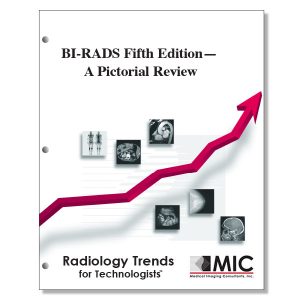

BI-RADS Fifth Edition — A Pictorial Review
Recent changes made to the BI-RADS lexicon are highlighted.
Course ID: Q00499 Category: Radiology Trends for Technologists Modalities: Mammography, Sonography1.75 |
Satisfaction Guarantee |
$24.00
- Targeted CE
- Outline
- Objectives
Targeted CE per ARRT’s Discipline, Category, and Subcategory classification for enrollments starting after February 14, 2023:
[Note: Discipline-specific Targeted CE credits may be less than the total Category A credits approved for this course.]
Breast Sonography: 1.25
Patient Care: 1.25
Patient Interactions and Management: 1.25
Mammography: 1.25
Procedures: 1.25
Anatomy, Physiology, and Pathology: 1.25
Magnetic Resonance Imaging: 0.50
Procedures: 0.50
Body: 0.50
Registered Radiologist Assistant: 1.75
Safety: 1.75
Patient Safety, Radiation Protection, and Equipment Operation: 1.75
Outline
- Introduction
- Brief History of BI-RADS
- Overview of BI-RADS Fifth Edition: Mammography Revisions
- Density
- Masses
- Calcifications
- Architectural Distortion
- Asymmetries
- Special Cases
- Associated Features
- Location of Lesion
- Overview of BI-RADS Fifth Edition: US Revisions
- Tissue Composition
- Masses
- Calcifications
- Associated Features
- Special Cases
- Overview of BI-RADS Fifth Edition: MR Imaging Revisions
- New Sections
- Focus
- Masses
- Nonmass Enhancement
- Associated Findings
- Location of Lesion
- Kinetic Curve Assessment
- MR Imaging: Implants
- Assessment Categories
- Guidance Subsection
- Improvements
- Conclusion
Objectives
Upon completion of this course, students will:
- list attributes that allow radiologists to communicate breast findings to referring physicians clearly and succinctly
- state what year the BI-RADS fifth edition lexicon was released
- recall how many years the BI-RADS fourth edition lexicon was in place
- describe goals of the first BI-RADS lexicon
- list all years in which a BI-RADS lexicon has been revised
- state the types of breast tissue
- list the mass shapes in the BI-RADS fifth edition: mammography revision section
- list the categories for determining breast density in the BI-RADS fifth edition: mammography revision section
- state the calcification categories in the BI-RADS fifth edition: mammography revision section
- recall the calcification categories in the BI-RADS fifth edition: mammography revision section
- state the increased risk for malignancy in amorphous calcifications
- explain terminology relative to breast asymmetries
- define developing asymmetry
- state how the term associated features is utilized to characterize masses, calcifications, and asymmetries
- name the new subsection addition to the breast ultrasound section of the BI-RADS fifth edition
- recall changes to the breast ultrasound section in the fifth edition of the BI-RADS lexicon
- list the terms describing tissue composition in the ultrasound section of the fifth edition, BI-RADS revisions
- note the simplification of posterior acoustic features to posterior features
- describe the difference between the category “vascularity” and the term “vascularity” in the ultrasound section of the BI-RADS fifth edition
- list the descriptors in the new section “elasticity assessment” of the ultrasound revisions
- tell how many sections for “associated findings” there are in the MR revisions of the BI-RADS fifth edition
- state how a mass is defined
- list mass descriptors for the MR section of the BI-RADS fifth edition
- name the two descriptor categories for margins in the MR section of the BI-RADS fifth edition
- state the non-mass enhancement term that has been eliminated in the MR section of the BI-RADS fifth edition
- describe the initial phase of the kinetic curve
- list the terms that describe the changes in the kinetic curve
- state the reasons for breast MR imaging of implants
- state the year the U.S. FDA halted the use of silicone breast implants for cosmesis
- recall the modality that does not use categories 4A,4B, or 4C for assessment
